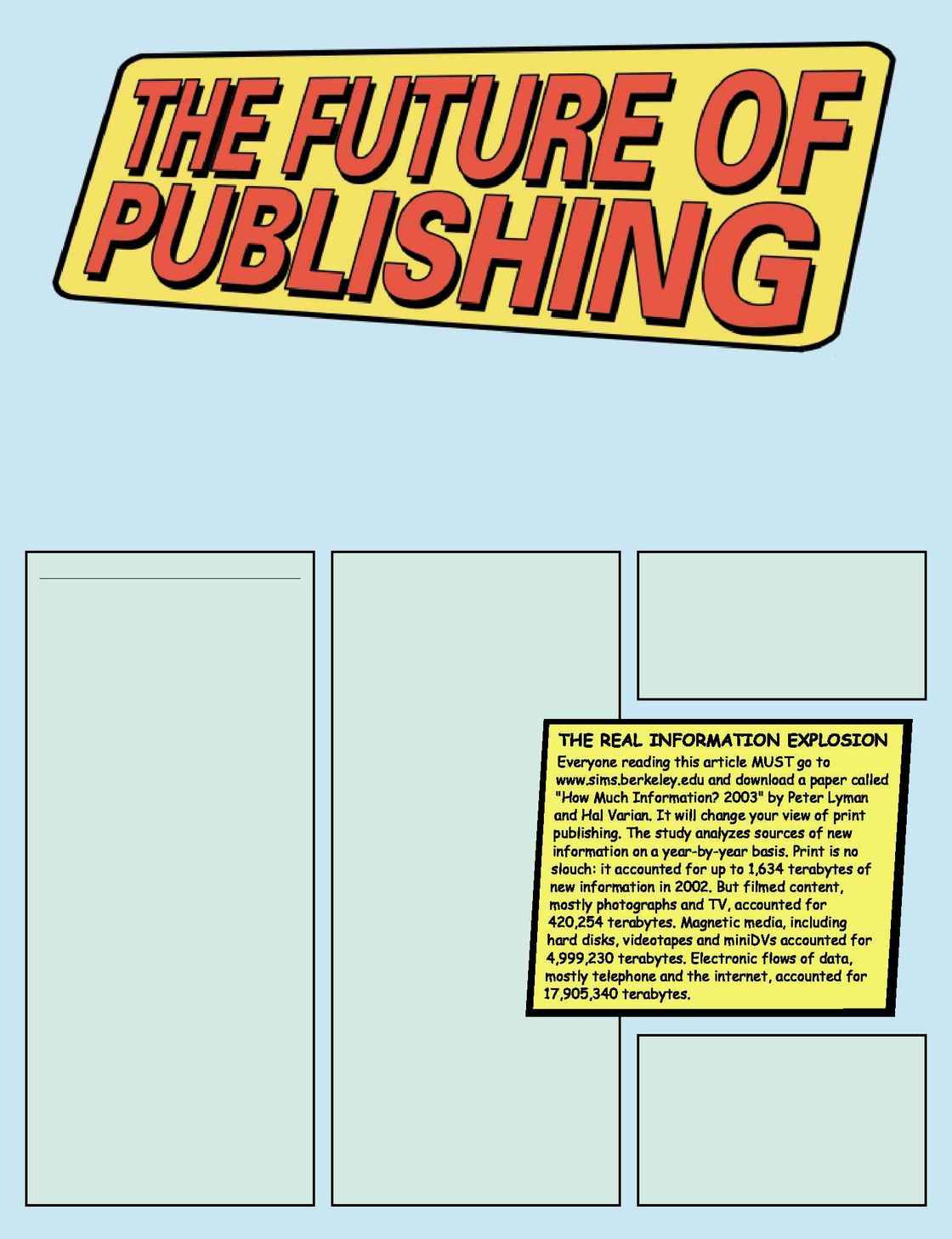
Media Agility
T
he future of publishing and the future of
printing are inextricably linked. The largest
reservoir of published information remains
in print. Most publishers continue to think
first of print when planning new publica-
tions. According to figures from Frank Romano, in
1997 publishing accounted for 41 per cent of total
print volume (PIA figures put it at 26.8 per cent; while
a study from HP, PODi and the paper industry indi-
cate that publishing accounted for 68 per cent of the
12.1-trillion pages printed in 1996).
So where did anyone get the idea that print is dead?
Print isn't even dying. At the same time it's foolhardy
to keep ignoring the fact that the internet and other
forms of new media are already having an enormous
impact on the printing and publishing business. That
impact will increase. People can spend only a limited
number of hours reading each day, and have a limit-
ed number of dollars to spend. What moves to the
internet has to come from somewhere. This may not
be a zero-sum game, but neither time nor discre-
tionary income is infinite.
To fully comprehend the changing print economy
you'll need to examine Graph 1 (page 24) from the
U.S.-based NAPL (National Association for Printing
Leadership). They were the first to break the news that
starting in the late 1990s, print sales were decoupled
from the overall growth of U.S. GDP, sometimes still
rising slightly, but often even falling against the con-
tinued strong GDP growth. The printing industry in
North America has always relied on GDP growth to
keep it afloat. It appears now that this relationship is
at or near its end.
There's a very different perspective on the situation
produced by UC Berkeley's School of Information
Management and Systems annual report: How Much
Information? 2003 (http://www.sims.berkeley.edu/
research/projects/how-much-info-2003/).
Measured against the worldwide production of
original information, print now records only 3.01 per
cent of the total. Email ranks second behind the tele-
phone as the largest information flow. Clearly print is
falling quickly within the communications mix.
It wasn't very long ago that the PIA (Printing
Industries of America) was reporting that "Printer's
Profits Hit Decade High" 1999, to be exact. Soon
after the Industry Growth Outlook Report published
by Integra Information predicted print industry
growth averaging 4.2 per cent in the years 1999 to
2003.
The PIA's famous Vision21 study offered that
printers' shipments of general commercial and
quick printing should increase by 4.7 per cent
through 2003 and 4.6 per cent
from 2004 to 2006.
Here's a picture that tells the real
story of what happened. The year
2000 was OK, but 2001 and 2002
were a disaster. 2003 is showing a
modest recovery,
but again
nowhere near GNP growth.
According to a 1999 Merrill
Lynch Printing Industry Report
and Federal Reserve Board
printing capacity statistics, the
printing industry was utilizing
less than 80 per cent of its
capacity in 2001.
While the profits of many
magazine publishers remain
healthy, readership figures paint
a different picture. A study
released by Leo Burnett's
Starcom Media Buying Unit
revealed that in 1998, while 15
magazines gained 18-million
adult impressions, 144 maga-
zines lost 79-million adult impressions. Overall,
audiences shrank by 5.9 per cent in one year.
Figures from the Magazine Publishers of
America (trade association) indicate that U.S. mag-
azine circulation peaked in 2000 at 378,918,978 and
had dropped by nearly six per cent in 2002 to
358,370,946.
Another study, this from Veronis, Suhler and
Associates looked at magazine readership versus
time spent on the internet in terms of hours spent
per month. By 1999 the adults in the survey were
spending 97 hours per month on the internet ver-
sus 81 hours per month reading magazines.
Projecting the data forward the firm estimates that
in the year 2003 those same adults will spend
192 hours per month on the internet versus
78 hours reading magazines. Another study from
Mediamark Research indicated that adults have
cut a half-hour from their weekly reading time
from 1998 to 1999.
Magazine vs. the Internet
Hours Spent Per Month
Internet
Magazines
1999
97
81
2003
192
78
Veronis, Suhler & Associates
Many of the surveys that examine media con-
sumption activities presuppose that the average
consumer is going to steal hours from non-media
By Thad McIlroy
"
It is not the strongest of the species that survives: nor the most intelligent;
it is the one that is most adaptable to change.
"
Charles Darwin
THE REAL INFORMATION EXPLOSION
Everyone reading this article MUST go to
www.sims.berkeley.edu and download a paper called
"How Much Information? 2003" by Peter Lyman
and Hal Varian. It will change your view of print
publishing. The study analyzes sources of new
information on a year-by-year basis. Print is no
slouch: it accounted for up to 1,634 terabytes of
new information in 2002. But filmed content,
mostly photographs and TV, accounted for
420,254 terabytes. Magnetic media, including
hard disks, videotapes and miniDVs accounted for
4,999,230 terabytes. Electronic flows of data,
mostly telephone and the internet, accounted for
17,905,340 terabytes.
